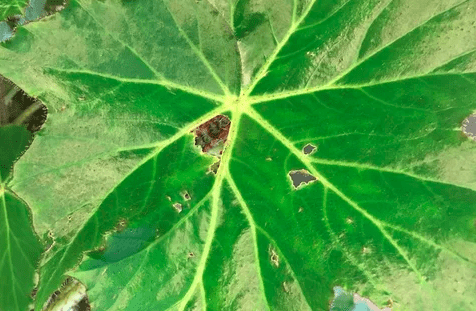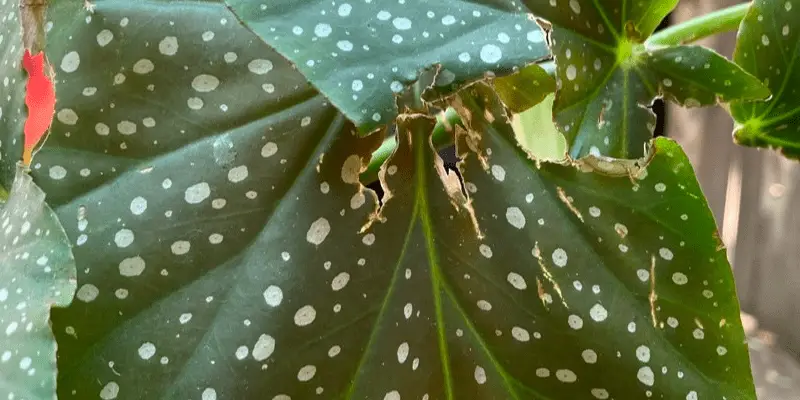Begonias are beautiful flowers that come in many different colors. They are a popular choice for gardens and indoor plants. However, that doesn’t mean problems never arise. One common issue is holes in begonia leaves.
In this blog post, we’ll discuss what could be causing holes in your begonia leaves and how to solve the issue.
Why Are There Holes in Begonias?
Pests are the main cause of holes in begonia leaves. Aphids, earwigs, beetles, slugs, and snails are all common pests that can cause damage to begonias. These pests chew on all areas of the plant, including the leaves.
These pests have a habit of hiding during the day and coming out at night to feed. This is why you may not see them when you’re inspecting your plant. Take a flashlight and look for pests at night to get a better idea of what’s causing the holes.
If you see slime trails, that’s a good indication that slugs or snails are the culprits. These pests are attracted to begonias because they’re looking for a juicy, soft meal. Other pests hide in small crevices and feed on the leaves from there.
How to Solve the Problem
Big pests, like slugs and snails, can be picked off by hand and removed from the plant. Smaller pests, like aphids, can be more difficult to get rid of. You may need to use an insecticide or natural predator to get rid of them.
For slugs and snails, the use of Richard Jackson Flower Power Organic Slug & Snail Control works wonders. Simply sprinkle it around the base of the plant and they will stay away.
If you have earwigs, using diatomaceous earth is a good way to get rid of them. This substance is made from fossilized algae and works by puncturing the exoskeletons of pests, causing them to dehydrate and die.
But my favorite product to get rid of small pests is Neem oil. Not only does this work well on every pest I’ve used it on, but it’s also organic and safe to use around the garden. Just be sure to cover all the affected areas and reapply every few days until the pests are gone.

How to Prevent Begonia Pests?
After you’ve gotten rid of the pests, you’ll want to take some steps to prevent them from coming back.
One way to do this is by using row covers. Row covers are pieces of fabric that go over plants and keep pests out. They’re great for preventing earwigs, beetles, and other crawling insects from getting to your begonias.
Another way to prevent pests is by using beneficial insects. These are insects that prey on common garden pests. Ladybugs and green lacewings are two examples of beneficial insects. You can purchase these online or at a local nursery.
Finally, make sure you’re regularly inspecting your plants and removing any dead leaves or stems. Keep the garden clean and tidy to make it less inviting for pests.
What Else Causes the Holes?
It’s true that pests should take most of the blame when it comes to holes in begonia leaves. However, there are other causes to consider as well.
1. Bad Weather
Harsh weather conditions can cause damage to begonia leaves. High winds can tear holes in the leaves, while hail can leave behind small dents or holes. It’s hard to escape harsh weather, but you can try to protect your plants by covering them with row covers or placing them in a sheltered spot.
2. Animals
Certain animals, like rabbits and deer, love to eat begonias. If you have animals in your yard, they may be the cause of holes in your begonia leaves. The best way to prevent this is by fencing them out of the garden.
Big animals tend to cause more damage than small animals, but even a squirrel or bird can cause holes in begonias. If you see an animal eating your plant, chase it away and try to keep them out of the garden in the future.
3. Disease
Like most plants, begonias are susceptible to disease. One common disease that affects begonias is botrytis blight. This disease causes the leaves to develop blocky, dark lesions. These lesions eventually cause the leaves to turn brown and die.
Another disease that can cause holes in begonia leaves is powdery mildew. This disease appears as a white or gray powder on the leaves and eventually covers the entire plant. Powdery mildew weakens the plant and makes it more susceptible to damage.
Should I Prune Begonias with Holes?
I usually only recommend pruning if the holes are caused by a fungal disease that is quickly spreading. If the holes are caused by pests, pruning is not necessary.
Pruning begonias with holes can help to prevent the spread of disease. However, it’s important to only prune away affected leaves and stems. Don’t go overboard and remove too much of the plant. This will only make it more difficult for the plant to recover.
If you do decide to prune, be sure to disinfect your pruning tools before and after use. This will help to prevent the spread of disease. Dispose of any affected leaves and stems in the trash, not the compost bin.
Conclusion
To sum up, holes in begonia leaves are most likely caused by pests. However, bad weather, animals, and disease can also cause damage to the leaves.
If you suspect that pests are causing holes in your begonia leaves, take action to get rid of them. The use of neem oil, row covers, garden cleanliness, and beneficial insects can help to keep pests away.
I hope this article has helped you to understand the cause of holes in begonia leaves. Be sure to take action if you see pests on your plants. And don’t forget to take some preventative measures to keep them from coming back. Thanks for reading!
Tim is an avid gardener from the UK. He was the founder of PlantCarer.com from 2021 to Sep 2023. He sold PlantCarer.com to Aaron. He has since started his own business called Seed To Supper, which provides new gardeners all the materials you need in a box (pots, seeds, compost and instructions) to grow your own delicious and nutritious vegetables and herbs from start to finish – no garden required.


My begonia plant is indoors it is growing and reproducing leaves but there are quite a few of them that have holes in them the new leaves that have come in also are getting holes first looks like a spot of lighter color and then turns to a whole if I started pruning all of those leaves I would hardly have any left. Any suggestions